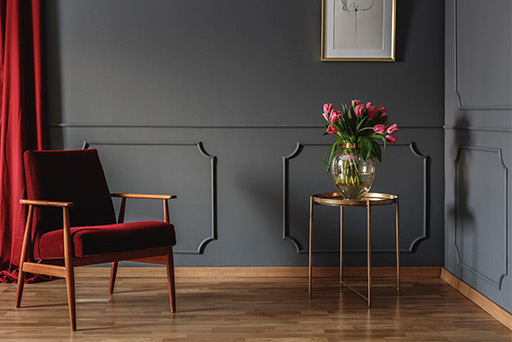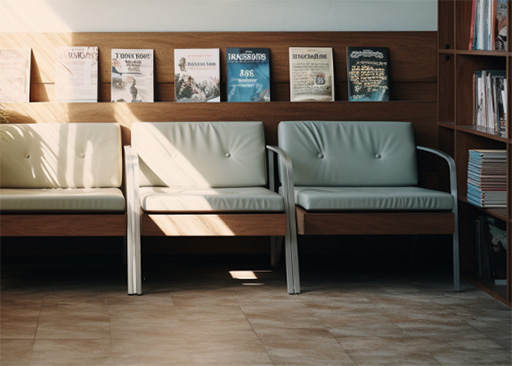The Ultimate Clinic Waiting Room For Your Office

If your patient experiences something during the appointment that is not entirely positive, that can impact your patient’s confidence in you. Even things that do not reflect your professional knowledge and abilities can impact your patient’s trust. For example,
The “Wait” in the Waiting Room
Your waiting room represents the first extension of your services to your patients. They must wait there before you can see them. Although waiting is expected, no one likes a long wait time. Therefore, you must do whatever you can to stick to your patients’ scheduled appointments.
Allow yourself enough time for each appointment, so you have ample time to finish with one patient before seeing your next one. Consistently seeing your patients late because the previous appointment is always running overtime will dampen the patient experience. The longer the wait times, the less satisfied they become. If you can stick to their scheduled times, you send them a message that you care about their time and that each one of them is essential to you.
Set Your Patient’s Expectations
With that said, no matter how organized you are with your patients’ appointments, there will be times when issues beyond your control will result in your patient waiting longer than expected. Although you cannot control all events, you can control how to make your patient less dissatisfied with this unexpected wait.
Keep in mind that people, by nature, are impatient creatures. When patients are sitting in the waiting room with nothing to do but wonder when it would be their turn to be seen by you, each minute that they wait can feel excruciatingly long. Waiting five minutes can seem like waiting 30 minutes from their perspective because they do not know how long they must wait.
An open-ended wait breeds uncertainty, and it can make your patient feel stressed. Remember, your patient is here to see you about a health issue. If it is combined with an uncertain wait, he will be very dissatisfied.
Therefore, it can help if you can set the patient’s expectations in advance about the length of the wait. For example, if you are running late, your front-office receptionist can politely get informed consent from your next patient to expect to wait x number of minutes. Your patient will appreciate being told instead of being subjected to an open-ended wait. He can still feel satisfied with the waiting room experience.
Engage Your Patients
If the waiting room is designed well, the wait can be an opportunity for patient engagement. You need to include ways to take your patient’s mind away from the delay and toward different types of activities. You may have gotten away with just providing a few old popular magazines, or television issues turned on to a daytime talk show in the past. However, people have become more sophisticated, and they expect more.
Your waiting room should provide a few distractions for your patient to engage. For example, a coffee and tea station allow your patients to fix themselves a beverage while they wait. In addition, the seating area can be enhanced by device charging capabilities like USB plugs so patients can work on their laptops or entertain themselves on their mobile devices. These minor enhancements to the waiting room can keep the waiting experience positive.

Add Value To The Wait
People usually do not mind waiting for something that they perceive is worth the wait, especially if the incentive is unique and has excellent value. When you apply this to your clinic waiting room setting, you can develop creative ways to add value to your patient’s waiting time. For example, one of the services you will be using on your patients is the BioScan system.
BioScan is state-of-the-art technology that allows for a thorough assessment of the patient’s current health in a non-invasive approach. Results are generated in an easy-to-read, color-coded report that you can give to your patient.
To introduce your patients to this advanced method of health assessment, why not provide some easy-to-read materials in your waiting room that briefly describe this service? The maker of BioScan offers many different types of brochures, posters, and handouts designed for the patient to introduce him to this system.
You can add more value to the waiting room by setting aside a “browsing library” of books and publications that your patients can peruse. You can even carry a few extra copies of the titles in your inventory so that if the patient wants to purchase a book, he can buy it at your front office. It is another way for you to keep your patients engaged while they are waiting for their appointments.
Design Of The Clinic Waiting Room
As mentioned earlier, your waiting room represents the first part of the services that you are providing to your patients. Considering the likelihood that your patients will spend some time in the waiting room, it is essential that the design and atmosphere of the waiting room feel comfortable and welcoming to your patients.


What Works Or Does Not Work
To assess how effective your current waiting room setup is, have your front desk staff observe the waiting room dynamics over the next few weeks. For example, while your patients are waiting, do they look bored? Are they impatient about the wait? Do they look uncomfortable? Are certain parts of the waiting room more popular than other areas (e.g., areas with access to an electric outlet are usually more popular because people want to charge their phones and devices)?
How do your patients interact with your interdisciplinary team? First, have your staff jot down some notes over the next few weeks. Then, at the end of the observation period, review your staff’s messages and see if you spot any recurring issues. These areas can help the focus of upgrading your waiting room.
Is your waiting room big enough to accommodate your patients? Keep in mind that sometimes patients are accompanied by their family members. Therefore, there should be enough comfortable seating, spaced out adequately, to accommodate your visitors.
Look at the space that you allocated to your front desk staff. Is your team using that space efficiently, or does it need to be modified? The staff and patient areas in the waiting room need to coexist in a well-balanced design. Your staff area should exude a welcoming feel so your patients will feel comfortable approaching the front desk if they have any questions while they wait.
Seating Options
In terms of how much space should be allowed for the seating of each visitor in the waiting room, your waiting area probably has a combination of individual seats and wider seats that fit more than one person. As a rule of thumb, you should allow an average of 20 square feet per visitor if you have individual seats and between 30 to 35 square feet per visitor if the seating is wider. Consider the time of day when you tend to have more patients in your clinic waiting room and use that number of visitors to determine your seating layout.
If there is room, you can have more electrical outlets installed so your patients can charge their phones and devices. In addition, you can allocate space for a water cooler and perhaps a table with items for coffee and tea. Just be mindful not to make the waiting room seem crowded with too many extra things.
The seating themselves should be comfortable. If you are designing your waiting from scratch and can try out different kinds of seating, take advantage of it. However, do not forget that your patients will sometimes have to sit in that same chair for 15 minutes or more. Would they be comfortable if they sat there for that long?
Accessible To Everyone
Your waiting room should be all-inclusive to the broadest range of patients. However, there might be patients who require special accommodations. For example, specific seating space should be accessible to those who need special accommodations like a wheelchair, a service animal, or medical equipment. An empty area next to one of the seats is usually sufficient. Arrange your seating so you can have several accessible seats in the waiting room.
You should include seating of different styles. For example, chairs without armrests are easier for patients who want to move from a wheelchair to the seat, whereas chairs with armrests are preferred by elderly patients who need the armrests for support. In addition, chairs with wider seats can accommodate physically bigger patients.
Seating types should be intermixed together rather than separated, so patients with mobility needs are not apart—for instance, pair wheelchair seating with a regular seat for the companion. In addition, if extra electrical outlets are provided for device charging, there should be at least one next to the accessible space so patients in a wheelchair can also enjoy the benefit of charging their devices.
Plot the seating layout, so the flow of traffic is smooth and logical. For instance, there should be a clear path going directly from the front door of your clinic to your front desk staff. Arrange seats so any patient can freely get up and approach your assessment rooms without bumping into another patient. Make sure there is enough space for a wheelchair to go through the waiting area.
Color and Lighting
The waiting room should promote a feeling of calm and relaxation. Patients with health issues are already tense, and waiting in a peaceful environment can be soothing. Avoid the sterile “hospital” look with bland walls and harsh lighting. If your waiting room has windows, allow natural lighting to fill the waiting area. General lighting in the waiting room should be soft, low, and warm. Use brighter spotlights to showcase display items.
The colors you use in the clinic waiting room should be soothing. Tones of greens, blues, and purples usually bring about a calm feeling. Avoid bright reds, oranges, and yellows on your walls because those colors are stimulating and may cause some patients to feel anxious.
Other Enhancements

These are just a few ideas on how you can use your clinic waiting room to help your patient have a positive experience. It is the ideal place to make a positive first impression of your practice. It is also a great place to introduce your patients to what the BioScan system is and how you will use it to assess your patient’s health. As a result, your patient will learn more about his health and take charge of his fitness.
